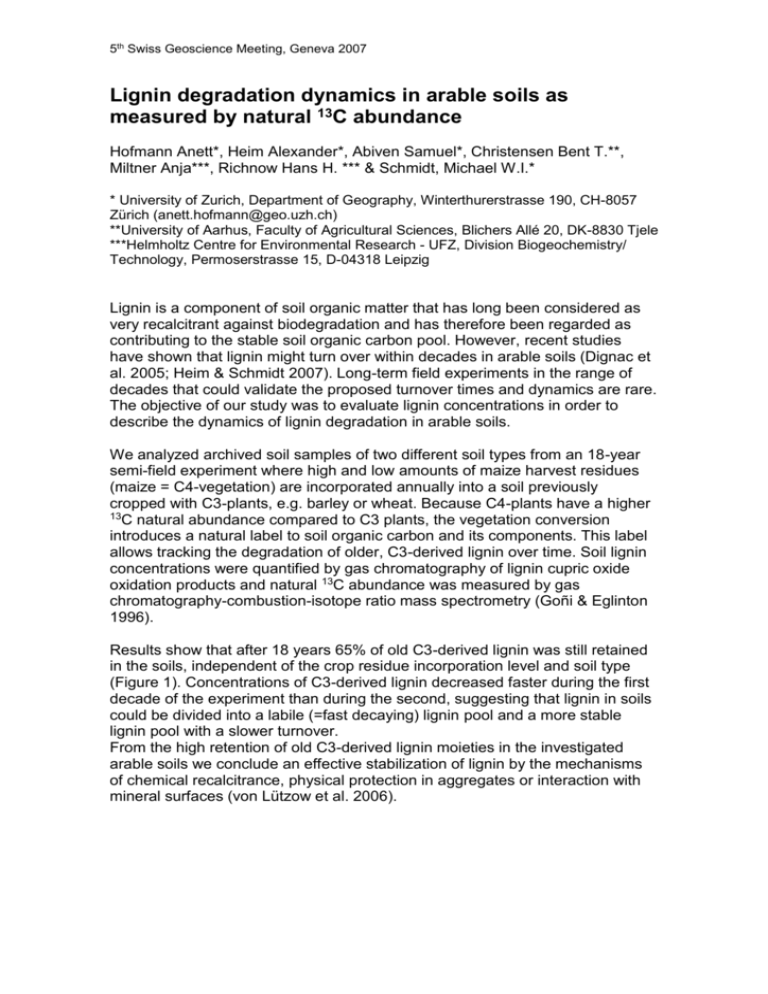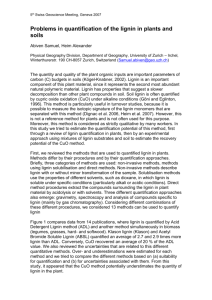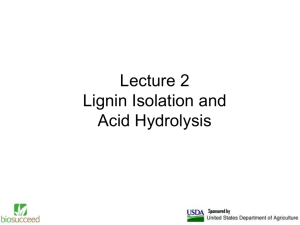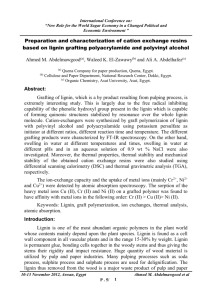Hofmann_Anett_Talk - SWISS GEOSCIENCE MEETINGs
advertisement

5th Swiss Geoscience Meeting, Geneva 2007 Lignin degradation dynamics in arable soils as measured by natural 13C abundance Hofmann Anett*, Heim Alexander*, Abiven Samuel*, Christensen Bent T.**, Miltner Anja***, Richnow Hans H. *** & Schmidt, Michael W.I.* * University of Zurich, Department of Geography, Winterthurerstrasse 190, CH-8057 Zürich (anett.hofmann@geo.uzh.ch) **University of Aarhus, Faculty of Agricultural Sciences, Blichers Allé 20, DK-8830 Tjele ***Helmholtz Centre for Environmental Research - UFZ, Division Biogeochemistry/ Technology, Permoserstrasse 15, D-04318 Leipzig Lignin is a component of soil organic matter that has long been considered as very recalcitrant against biodegradation and has therefore been regarded as contributing to the stable soil organic carbon pool. However, recent studies have shown that lignin might turn over within decades in arable soils (Dignac et al. 2005; Heim & Schmidt 2007). Long-term field experiments in the range of decades that could validate the proposed turnover times and dynamics are rare. The objective of our study was to evaluate lignin concentrations in order to describe the dynamics of lignin degradation in arable soils. We analyzed archived soil samples of two different soil types from an 18-year semi-field experiment where high and low amounts of maize harvest residues (maize = C4-vegetation) are incorporated annually into a soil previously cropped with C3-plants, e.g. barley or wheat. Because C4-plants have a higher 13C natural abundance compared to C3 plants, the vegetation conversion introduces a natural label to soil organic carbon and its components. This label allows tracking the degradation of older, C3-derived lignin over time. Soil lignin concentrations were quantified by gas chromatography of lignin cupric oxide oxidation products and natural 13C abundance was measured by gas chromatography-combustion-isotope ratio mass spectrometry (Goñi & Eglinton 1996). Results show that after 18 years 65% of old C3-derived lignin was still retained in the soils, independent of the crop residue incorporation level and soil type (Figure 1). Concentrations of C3-derived lignin decreased faster during the first decade of the experiment than during the second, suggesting that lignin in soils could be divided into a labile (=fast decaying) lignin pool and a more stable lignin pool with a slower turnover. From the high retention of old C3-derived lignin moieties in the investigated arable soils we conclude an effective stabilization of lignin by the mechanisms of chemical recalcitrance, physical protection in aggregates or interaction with mineral surfaces (von Lützow et al. 2006). 5th Swiss Geoscience Meeting, Geneva 2007 Figure 1. About two thirds of the initial concentration of old lignin was still retained by both soil types 18 years after the start of the experiment. This finding suggests effective stabilization mechanisms for lignin. Soil type and levels of crop residue incorporation had no influence on the degradation dynamics of lignin. The biexponential curve was fitted by solving for the least square difference assuming a rate constant of 0.0047 a-1 for the stable pool (Lobe et al. 2002). Labile pool: 34 %, klabile pool 0.17; stable pool: 66 %. REFERENCES Dignac, M.-F., Bahri, H., Rumpel, C., Rasse, D.P., Bardoux, G., Balesdent, J., Girardin, C., Chenu, C., Mariotti, A. 2005. Carbon-13 natural abundance as a tool to study the dynamics of lignin monomers in soil: an appraisal at the Closeaux experimental field (France). Geoderma 128, 3-7. Goñi, M.A., Eglinton, T.I. 1996. Stable carbon isotopic analyses of lignin-derived CuO oxidation products by isotope ratio monitoring-gas chromatography-mass spectrometry (irm-GC-MS). Organic Geochemistry 24, 601-615. Heim, A. & Schmidt, M.W.I. 2007. Lignin turnover in arable soil and grassland analysed with two different labelling approaches. European Journal of Soil Science 58, 599-608 Lobe, I., Du Preez, C.C., Amelung, W. 2002. Influence of prolonged arable cropping on lignin compounds in sandy soils of the South African Highveld. European Journal of Soil Science 53, 553-562. von Lützow, M., Kögel-Knabner, I., Ekschmitt, K., Matzner, E., Guggenberger, G., 2006. Stabilization of organic matter in temperate soils: mechanisms and their relevance under different soil conditions. European Journal of Soil Science 57, 426-445.







